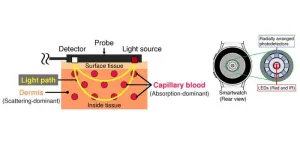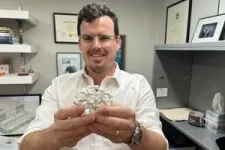(Press-News.org) Diabetes is an increasingly pervasive disease, currently affecting over 500 million adults worldwide. Since there is as yet no cure for type 1 or type 2 diabetes, patients must regularly monitor their BGLs to keep them in check. Though BGL-measuring devices relying on painful finger pricks have been the gold standard for decades, modern technology is slowly opening doors to better alternatives.
Many researchers have proposed noninvasive methods to monitor BGLs using widely available wearable devices, such as smartwatches. For example, by placing the LEDs and photodetectors present in certain smartwatches against the skin, oxyhemoglobin and hemoglobin pulse signals can be measured to calculate a metabolic index, from which BGLs can be estimated. However, given the small size and limited power of smartwatches and similar wearables, the data quality of the measured signals tends to be quite low. Moreover, as these devices are worn on extremities, daily movements introduce measurement errors. These problems limit the accuracy and clinical applicability of such wearables for diabetes management.
A team from Hamamatsu Photonics K.K., Japan, has been actively researching this issue, looking for effective solutions. In a recent study led by Research and Development Engineer Tomoya Nakazawa, published in the Journal of Biomedical Optics (JBO), they conducted an in-depth theoretical analysis of the sources of errors in the metabolic-index-based method. Based on this analysis, they implemented a novel signal quality index to filter out low-quality data as a preprocessing step and thereby enhance the accuracy of estimated BGLs.
“As smartwatches are widely adopted across different regions and age groups, and with the global rise in diabetes cases, a signal quality enhancing method that is easy to implement and apply regardless of personal and individual differences is absolutely essential for meeting the increasing worldwide demand for noninvasive glucose monitoring devices,” remarks Nakazawa, explaining the motivation behind the study.
First, the researchers mathematically showed that discrepancy between the two types of phase delays in the oxyhemoglobin and hemoglobin pulse signal calculated by different methods provides a good measure of the influence of noise. They then considered two main sources of phase error, namely, a background noise level and the estimation errors introduced via sampling at discrete intervals. After formalizing these sources of errors, they calculated the effect on the estimated metabolic index.
The proposed screening approach involves implementing thresholds for the phase estimation and metabolic index errors. Data chunks that exceed the set thresholds are discarded, and the missing values are approximated using other means based on the rest of the data.
To test this strategy, the researchers conducted a long-term experiment in which the sensors in a commercial smartwatch were used to monitor the BGLs of a healthy individual during “oral challenges.” In each of the 30 tests conducted over four months, the subject would fast for two hours before consuming high-glucose foods. Their BGLs were measured using the smartwatch and a commercial continuous glucose monitoring sensor, the latter of which was used to capture the reference values.
Notably, preprocessing the data with the proposed screening method led to a notable increase in accuracy. Using the Parkes error grid technique to categorize measurement errors, a substantially higher percentage of data points ended up in Zone A when screening was applied. This refers to clinically accurate values that would lead to correct treatment decisions. “Adopting the screening process improved BGL estimation accuracy in our smartwatch-based prototype,” remarks Nakazawa, “Our technique could facilitate the integration of wearable and continuous BGL monitoring into devices such as smartwatches and smart rings, which are typically constrained in terms of size and signal quality,” he adds, highlighting the impact of the research work.
The research team also noted some of the current limitations of smartwatches that lead to inferior performance compared to smartphone camera-based techniques. Though the proposed method could certainly help enhance the performance of the former, hardware improvements in the photodetector and amplifier circuits could go a long way to make wearable electronics a more attractive and clinically acceptable option to monitor BGLs.
Further research in this area will help provide patients with diabetes with powerful tools so that they can manage their condition better, leading to a higher quality of life.
For details, see the original Gold Open Access article by T. Nakazawa et al., “Accuracy enhancement of metabolic index-based blood glucose estimation with a screening process for low-quality data,” J. Biomed. Opt. 29(10), 107001 (2024), doi: 10.1117/1.JBO.29.10.107001.
END
Enhancing the accuracy of wearables that measure blood glucose levels
A newly developed screening technique filters out low-quality data to improve the performance of smartwatch-based sensors for noninvasive blood glucose estimation
2024-10-28
ELSE PRESS RELEASES FROM THIS DATE:
Increasing social supports for new mothers with opioid use disorder
2024-10-28
Opioid use disorder (OUD) is a growing public health problem among pregnant and parenting people in the U.S. Between 1999 and 2014, the number of pregnant women with OUD increased by more than four times. This trend also coincides with a rise in pregnancy-associated maternal overdose mortality.
Researchers at Thomas Jefferson University, led by Meghan Gannon, PhD, MSPH, investigated how community-based supports, like doulas, can be integrated into health care for mothers who use opioids. Using a social network analysis, ...
Mitigating the neurotoxic effects of lead exposure
2024-10-28
Lead exposure is a risk to any human, but children are most vulnerable to the element’s neurotoxicity, which can lead to developmental delays, learning difficulties and mood changes among other symptoms. There has been some progress in reducing exposure and preventing neurotoxicity, but hundreds of thousands of American children are still affected.
A new study by Thomas Jefferson University neuroscientist Jay Schneider, PhD, suggests that the toxic effects of lead can be mitigated by attentive maternal care and an enriched environment ...
Developing kidneys from scratch
2024-10-28
To Alex Hughes, Assistant Professor in Bioengineering within Penn Engineering and in Cell and Developmental Biology within Penn Medicine, the kidney is a work of art. “I find the development of the kidney to be a really beautiful process,” says Hughes.
Most people only ever see the organ in cross-section, through textbooks or by dissecting animal kidneys in high school biology class: a bean-shaped slice with lots of tiny tubes. “I think that really undersells how amazing the structure is,” says ...
Airbnbs associated with more crime in London, new study shows
2024-10-28
Since its founding in 2008, the short-term homestay platform Airbnb has expanded to 100,000 cities in more than 220 countries, and, according to data from the company, 1.5 billion guests had stayed in Airbnb-listed properties through 2023.
Much of the academic research on Airbnb activity comes from economics and business literature and focuses on housing-supply impacts, says David Kirk, professor of criminology at the University of Pennsylvania. Yet research on neighborhood impacts is limited, and that research neglects the impacts of Airbnb activity on measures of community cohesion and safety.
Kirk teamed with University of Cambridge criminologist ...
New study finds invasive plants drive homogenization of soil microbial communities across U.S.
2024-10-28
Invasive plants are doing more than just taking over landscapes — they’re also changing the soil beneath them. A new study co-authored by Matthew McCary, assistant professor of biosciences at Rice University, reveals that these species are reshaping soil microbial communities across the U.S., making them more uniform and altering how ecosystems function. The findings, published in Proceedings of the National Academy of Sciences on Oct. 24, shed light on the far-reaching impacts of invasive plants, which extend beyond what we see above ground.
The ...
Researchers’ new outreach strategy succeeds, sets blueprint for detecting invasive species in Florida
2024-10-28
Invasive species in Florida like Nile monitors and Argentine black-and-white tegus pose a growing threat to the Sunshine State’s environment, economy and public safety. South Florida’s warm climate, disturbed habitats and bustling pet trade have made it a hotspot for these non-native, cryptic reptiles. However, finding these elusive creatures has always been a challenge – until now.
University of Florida researchers are showcasing how a focused outreach initiative in Palm Beach County has led to a successful increase in reports of invasive reptiles in Florida. The findings are documented in the latest study published in Scientific Reports and authored by researchers at UF/IFAS ...
Discovery of critical iron-transport protein in malaria parasites could lead to faster-acting medications
2024-10-28
Malaria kills over 600,000 people a year, and as the climate warms, the potential range of the disease is growing. While some drugs can effectively prevent and treat malaria, resistance to those drugs is also on the rise.
New research from University of Utah Health has identified a promising target for new antimalarial drugs: a protein called DMT1, which allows single-celled malaria parasites to use iron, which is critical for parasites to survive and reproduce.
The results suggest that medications that block DMT1 might be very effective against malaria.
The new results are published in PNAS.
An ironic mystery
Paul Sigala, ...
Risky choices: How US laws affect migrant children’s journeys to border
2024-10-28
U.S. immigration law and the legal categorizations it imposes on migrants shape the journeys of migrant children from Central America as they move through Mexico toward the southern U.S. border, according to a new Yale study.
In the study, sociologist Ángel Escamilla García documents the various hard decisions Central American youth are forced to make during their journeys to maximize their chances of not being deported once they reach the United States. Those choices include concealing sexual assaults, beatings, and other crimes ...
Scientists address risks to supply chain in a connected world
2024-10-28
RICHLAND, Wash.—Scientists are gathering at the Department of Energy’s Pacific Northwest National Laboratory this week for a first-ever conference to consider ways to protect critical systems such as our electrical grid, water treatment plants and financial networks that are vulnerable in new ways.
The Cyber Supply Chain Risk Management Conference, known as CySCRM 2024, is being held on the PNNL campus Tuesday-Wednesday, Oct. 29-30.
It’s a new kind of science meeting, one that scientist Jess Smith and colleagues felt compelled to create as they eye a new kind of risk—a ...
Don’t skip colonoscopy for new blood-based colon cancer screening, study concludes
2024-10-28
Newly available blood tests to screen for colorectal cancer sound far more appealing than a standard colonoscopy. Instead of clearing your bowels and undergoing an invasive procedure, the tests require only a simple blood draw. But are the tests effective?
A study led by researchers at Stanford Medicine concluded that the new tests are ideal for people who shy away from other colorectal cancer screening. However, if too many people who would have undergone colonoscopies or stool-based tests switch to the blood tests, colorectal cancer death rates will rise. Because the more established colonoscopies and stool tests ...
LAST 30 PRESS RELEASES:
Implant provides lasting relief for treatment-resistant depression
Autologous T cell therapy targeting multiple antigens shows promise treating pancreatic cancer
First extensive study into marsupial gut microbiomes reveals new microbial species and antimicrobial resistance
Study debunks myth of native Hawaiians causing bird extinctions
Tailored biochar could transform how crops grow, resist disease, and clean polluted soils
Biochar-based enzyme technology offers new path for cleaner water and soil
Biochar helps farmland soils withstand extreme rain and drought by steadying carbon loss
New study reveals major gaps in global forest maps
Ochsner Health names Dr. Timothy Riddell executive vice president and chief operating officer
Can future-focused thoughts help smokers quit?
From brain scans to alloys: Teaching AI to make sense of complex research data
Stem Cell Reports seeks early career editors to join the editorial board
Signs of ancient life turn up in an unexpected place
Pennington Biomedical researchers explore factors behind body’s ability to regulate weight
Zhongping Lee awarded the Nils Gunnar Jerlov Medal
Deborah S. Kelley awarded the Wallace S. Broecker Medal
Novel immunotherapy demonstrates early potential to overcome resistance to immune checkpoint therapy
LLM treatment advice agrees with physician recommendations in early-stage HCC, but falls short in late stage
Deep learning model trained with stage II colorectal cancer whole slide images identifies features associated with risk of recurrence – with higher success rate than clinical prognostic parameters
Aboard the International Space Station, viruses and bacteria show atypical interplay
Therapies that target specific type of cell death may be an effective avenue for cancer treatment, UTHealth Houston researchers find
CHEST releases guideline on biologic management in severe asthma
Scientists create a system for tracking underwater blackouts
Fruit fly pigmentation guides discovery of genes that control brain dopamine and sleep
World's largest physics conference to be held in Denver and online this March
New mega-analysis reveals why memory declines with age
Understanding ammonia energy’s tradeoffs around the world
UTHealth Houston researchers map gene disruptions in sporadic early onset Alzheimer’s disease across key brain regions
Minimum wage increases are linked to safer pregnancies
Left in the cold: Study finds most renters shut out of energy-saving upgrades
[Press-News.org] Enhancing the accuracy of wearables that measure blood glucose levelsA newly developed screening technique filters out low-quality data to improve the performance of smartwatch-based sensors for noninvasive blood glucose estimation






